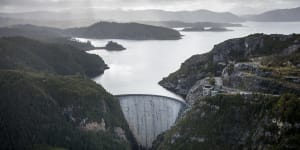The Marinus Link,a joint venture between the federal government,Victoria and Tasmania,was expected to cost $3 billion in 2017 for two 750-megawatt cables,but costs ballooned to an estimated $6 billion due to global inflation,spiralling steel prices and supply chain disruptions.

Hydro Tasmania’s Gordon Dam on Lake Gordon. The Marinus Link would send power stored in Tasmania’s hydroelectric dams to the mainland.Peter Mathew
Federal Energy Minister Chris Bowen revealed on Sunday that the venture would proceed with only a single cable,costing $3.3 billion,in response to the cost blowout. He said the goal was to begin delivering power to the mainland by 2028.
He said the single cable would deliver about two-thirds of the benefits that would have come from having two cables,and that it would boost energy security on both sides of the Bass Strait by backing up Tasmania’s renewable generation in the darker months of winter and filling gaps on the eastern seaboard.
“Marinus Link is an important project for Australia’s renewable transformation and a vital project for Tasmania as well as the mainland,” Bowen said.
He confirmed on Sunday that the Albanese government has increased its stake to 49 per cent of the joint venture,in which Victoria has a 33.3 per cent share and Tasmania now has 17.7 per cent,with an option to sell its stake to the Commonwealth on completion.
His announcement followed Tasmanian Energy Minister Guy Barnett’s comments last month that there was a “line in the sand” on costs his state would not cross.
The additional commitment is worth about $76 million,bringing the federal government’s total contribution to $1.6 billion. Those funds will be sourced from the $20 billion Rewiring the Nation fund for new electricity transmission projects.
involves installation of a 255-kilometre high-voltage interconnector under the Bass Strait,between north-west Tasmania and Waratah Bay in South Gippsland,Victoria,to send power stored in Tasmania’s hydroelectric dams,generated by the state’s burgeoning solar and wind farms.
Hydro Tasmania,the state-owned energy generator,says Marinus Link would enable it to realise its vision for the state to become the “battery of the nation”,and on Sunday said it can now expand the Tarraleah hydroelectric project and develop another one at Lake Cethana.
“Marinus Link is the linchpin,” said Hydro Tasmania chief executive Ian Brooksbank. “It will attract the new wind developments needed to meet the future energy needs of Tasmanians and industry,and it will deliver the energy security needed for business confidence.”
This masthead that the cost of the Snowy 2.0 pumped hydro project in Kosciuszko National Park,NSW,had blown out by more than $6 billion,to a total of $12 billion.
The Albanese government has committed to double the share of clean energy in the grid to 82 per cent by 2030,and the rise of renewables is undercutting fossil fuels,spurring early closures of coal plants across the eastern seaboard.
There is an urgent need to for new energy storage projects that back up renewables when the sun isn’t shining and wind isn’t blowing,which could include pumped hydro,batteries or gas plants.

The independent electricity grid operator warned last week any delays to current projects would increase the risks of blackouts this summer,with expected risking surges in demand for air-conditioning during heatwaves.
Get to the heart of what’s happening with climate change and the environment. Our fortnightly Environment newsletter brings you the news,the issues and the solutions. Sign up.